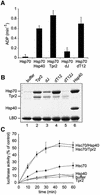Cofactor Tpr2 combines two TPR domains and a J domain to regulate the Hsp70/Hsp90 chaperone system
- PMID: 12853476
- PMCID: PMC165632
- DOI: 10.1093/emboj/cdg362
Cofactor Tpr2 combines two TPR domains and a J domain to regulate the Hsp70/Hsp90 chaperone system
Abstract
In the eukaryotic cytosol, Hsp70 and Hsp90 cooperate with various co-chaperone proteins in the folding of a growing set of substrates, including the glucocorticoid receptor (GR). Here, we analyse the function of the co-chaperone Tpr2, which contains two chaperone-binding TPR domains and a DnaJ homologous J domain. In vivo, an increase or decrease in Tpr2 expression reduces GR activation, suggesting that Tpr2 is required at a narrowly defined expression level. As shown in vitro, Tpr2 recognizes both Hsp70 and Hsp90 through its TPR domains, and its J domain stimulates ATP hydrolysis and polypeptide binding by Hsp70. Furthermore, unlike other co-chaperones, Tpr2 induces ATP-independent dissociation of Hsp90 but not of Hsp70 from chaperone-substrate complexes. Excess Tpr2 inhibits the Hsp90-dependent folding of GR in cell lysates. We propose a novel mechanism in which Tpr2 mediates the retrograde transfer of substrates from Hsp90 onto Hsp70. At normal levels substoichiometric to Hsp90 and Hsp70, this activity optimizes the function of the multichaperone machinery.
Figures







Similar articles
-
Role of the cochaperone Tpr2 in Hsp90 chaperoning.Biochemistry. 2008 Aug 5;47(31):8203-13. doi: 10.1021/bi800770g. Epub 2008 Jul 12. Biochemistry. 2008. PMID: 18620420
-
Differential effects of the hsp70-binding protein BAG-1 on glucocorticoid receptor folding by the hsp90-based chaperone machinery.J Biol Chem. 1999 Nov 26;274(48):34134-40. doi: 10.1074/jbc.274.48.34134. J Biol Chem. 1999. PMID: 10567384
-
Binding of immunophilins to the 90 kDa heat shock protein (hsp90) via a tetratricopeptide repeat domain is a conserved protein interaction in plants.Biochemistry. 1996 Dec 3;35(48):15249-55. doi: 10.1021/bi9615349. Biochemistry. 1996. PMID: 8952474
-
More than folding: localized functions of cytosolic chaperones.Trends Biochem Sci. 2003 Oct;28(10):541-7. doi: 10.1016/j.tibs.2003.08.009. Trends Biochem Sci. 2003. PMID: 14559183 Review.
-
Hsp70 and Hsp90--a relay team for protein folding.Rev Physiol Biochem Pharmacol. 2004;151:1-44. doi: 10.1007/s10254-003-0021-1. Epub 2004 Jan 23. Rev Physiol Biochem Pharmacol. 2004. PMID: 14740253 Review.
Cited by
-
Hsp70 chaperones: cellular functions and molecular mechanism.Cell Mol Life Sci. 2005 Mar;62(6):670-84. doi: 10.1007/s00018-004-4464-6. Cell Mol Life Sci. 2005. PMID: 15770419 Free PMC article. Review.
-
Differential impact of tetratricopeptide repeat proteins on the steroid hormone receptors.PLoS One. 2010 Jul 22;5(7):e11717. doi: 10.1371/journal.pone.0011717. PLoS One. 2010. PMID: 20661446 Free PMC article.
-
Imbalances in the Hsp90 Chaperone Machinery: Implications for Tauopathies.Front Neurosci. 2017 Dec 22;11:724. doi: 10.3389/fnins.2017.00724. eCollection 2017. Front Neurosci. 2017. PMID: 29311797 Free PMC article. Review.
-
The evolution of heat shock protein sequences, cis-regulatory elements, and expression profiles in the eusocial Hymenoptera.BMC Evol Biol. 2016 Jan 19;16:15. doi: 10.1186/s12862-015-0573-0. BMC Evol Biol. 2016. PMID: 26787420 Free PMC article.
-
In silico analysis of the HSP90 chaperone system from the African trypanosome, Trypanosoma brucei.Front Mol Biosci. 2022 Sep 23;9:947078. doi: 10.3389/fmolb.2022.947078. eCollection 2022. Front Mol Biosci. 2022. PMID: 36213128 Free PMC article.
References
-
- Brinker A., Scheufler,C., Von Der Mulbe,F., Fleckenstein,B., Herrmann,C., Jung,G., Moarefi,I. and Hartl,F.U. (2002) Ligand discrimination by TPR domain. Relevance and selectivity of EEVD-recognition in Hsp70–Hop–Hsp90 complexes. J. Biol. Chem., 277, 19265–19275. - PubMed
-
- Buchner J. (1999) Hsp90 & Co.—a holding for folding. Trends Biochem. Sci., 24, 136–141. - PubMed
-
- Bukau B. and Horwich,A. (1998) The Hsp70 and Hsp60 chaperone machines. Cell, 92, 351–366. - PubMed
-
- Chen S. and Smith,D.F. (1998) Hop as an adaptor in the heat shock protein 70 (Hsp70) and Hsp90 chaperone machinery. J. Biol. Chem., 273, 35194–35200. - PubMed
-
- Dittmar K.D., Demady,D.R., Stancato,L.F., Krishna,P. and Pratt,W.B. (1997) Folding of the glucocorticoid receptor by the heat shock protein (hsp) 90-based chaperone machinery. The role of p23 is to stabilize receptor–hsp90 heterocomplexes formed by hsp90–p60–hsp70. J. Biol. Chem., 272, 21213–21220. - PubMed
Publication types
MeSH terms
Substances
LinkOut - more resources
Full Text Sources
Other Literature Sources
Molecular Biology Databases
Research Materials

